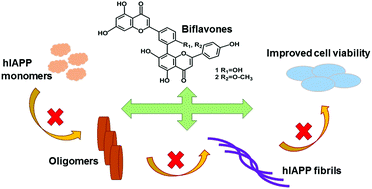Biflavones inhibit the fibrillation and cytotoxicity of the human islet amyloid polypeptide†
Abstract
Biflavones are a kind of natural compound with a variety of biological activities, which have the capability of reversing diabetes and neurodegenerative diseases. The human islet amyloid polypeptide (hIAPP) is closely related to the pathological process of type II diabetes mellitus (T2DM). The development of new inhibitors is crucial to prevent hIAPP aggregation against T2DM. However, the influences of biflavones on hIAPP aggregation are unknown. In this work, we utilized a series of biophysical and biochemical techniques to seek the inhibitory effects of two biflavones on hIAPP fibril formation and their interaction mechanism. The biflavones namely amentoflavone (1), and bilobetin (2), distinctly prevented the self-assembly behavior of hIAPP, and depolymerized the aged aggregates to small oligomers and monomers. In addition, the two compounds displayed strong binding affinity to hIAPP mainly through hydrophobic and hydrogen bonding interactions, and the hydroxyl substitution in 1 was superior to the methoxy substitution in 2 at the same C8 position in impeding hIAPP aggregation. 1 and 2 also decreased hIAPP-induced cytotoxicity by reducing peptide oligomerization. This work offers useful data for understanding the roles of biflavones in hIAPP fibrillation and for the treatment of T2DM and other amyloidosis related diseases.



 Please wait while we load your content...
Please wait while we load your content...